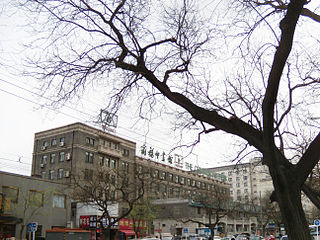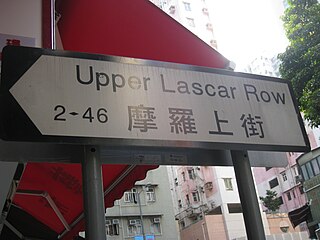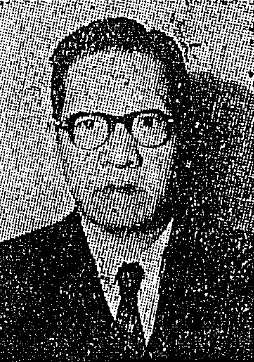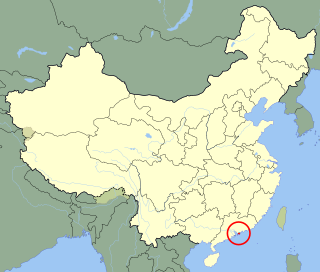
The Hong Kong Museum of Art (HKMoA) is the first and main art museum of Hong Kong, located in Salisbury Road, Tsim Sha Tsui. It is a public museum managed by the Leisure and Cultural Services Department of the Hong Kong Government. HKMoA has an art collection of over 17,000 items. Admission is free for permanent exhibitions. Its rival is the non-government-managed Hong Kong Arts Centre. These two museums are considered to be the top two art museums in Hong Kong that dictate the discourse of art in Hong Kong.
Shina is a largely archaic Japanese name for China. The word was originally used neutrally, but came to be perceived as derogatory by the Chinese during the course of the First and Second Sino-Japanese Wars. As a result, it fell into disuse following World War II and is now viewed as offensive, with the standard Japanese name for China being replaced by Chūgoku (中国).

Helen Liang Memorial Secondary School (Shatin) (HLMSS, Chinese: 梁文燕紀念中學(沙田)) is a secondary school in Sha Tin, Hong Kong. The primary school division was founded in 1961, while the secondary school division was founded in 1977 and relocated to the current site of Sha Tin in 1988.
Hong Kong Post is a Japanese-language weekly newspaper published in Hong Kong every Friday and owned by Mikuni Company. The newspaper first appeared in June 1987. It used to be sold in shops such as Citysuper, but is now free. It was formerly published by Pasona Press (HK) Co., Ltd.

The Commercial Press is the first modern publishing organisation in China. The Commercial Press is known for its academic translation and publications in humanities and social sciences as well as the Xinhua Dictionary.
The Daily Press was an English-language newspaper in Hong Kong, published from 1857 for about 80 years. Founded and edited by George M Ryder, it was the first daily newspaper in Hong Kong. In 1858, Yorick Jones Murrow, a tenacious Welshman born in 1817, took over the newspaper and he inaugurated the Chinese-language paper Hongkong Chinese and Foreign News (香港中外新報), published three times per week.Murrow led the paper on fearless attacks on the Colonial administration, leading ultimately to his imprisonment on a charge of libel. He relinquished his role as editor in 1867 but remained its proprietor till his death in 1884.

Zhonghua Book Company (simplified Chinese: 中华书局有限公司; traditional Chinese: 中華書局有限公司; pinyin: Zhōnghuá Shūjú Yoǔxìan Gōngsī), formerly spelled Chunghwa or Chung-hua Shu-chü, and sometimes translated as Zhonghua Publishing House, are Chinese publishing houses that focuses on the humanities, especially classical Chinese works. Currently it has split into a few separate companies. The main headquarters is in Beijing, while Chung Hwa Book (Hong Kong) is headquartered in Hong Kong. The Taiwan branch is headquartered in Taipei.
Quan Hansheng was a Chinese Economic historian. Quan's research focused on Chinese monetary history, commodity prices and foreign trade. He elected an Academician of Academia Sinica in 1984, and he held professorships at National Taiwan University and The Chinese University of Hong Kong.

Lascar Row is the combined name of two streets between Hollywood Road and Queen's Road Central in Sheung Wan, Hong Kong, Upper Lascar Row (摩羅上街) and Lok Ku Road. The immediate area is notable for its antique stalls.

Li Tse-fong李子方 was a Hong Kong entrepreneur and politician. He was a founder of the Bank of East Asia and member of the Legislative Council of Hong Kong.

The Hong Kong Japanese School and Japanese International School (HKJS&JIS) is a Japanese international school in Hong Kong. It consists of a Japanese section and international section. The Hong Kong Japanese School Limited operates the school system.
Sino United Publishing (Holdings) Limited is Hong Kong's largest integrated publishing group, formed in 1988 from the integration of some of the historic publishing agencies. Its business includes publishing, distribution, retail, printing, RFID packaging design, art business, cultural exchanges. It has subsidiaries and affiliated agencies throughout Hong Kong and Macao, mainland China, Singapore, Malaysia, as well as in North America, Europe etc.

Leung Ping-kwan, whose pen name was Yesi, was a Hong Kong poet, novelist, essayist, translator, teacher, and scholar who received the Hong Kong Medal of Honor (MH). He was an important long-time cultural figure in Hong Kong.
Timothy Wong Man-kong is a historian from Hong Kong and associate professor within the Department of History at Hong Kong Baptist University. He earned a bachelor's degree from Hong Kong Baptist College followed by MPhil and PhD, both at the Chinese University of Hong Kong. Wong was elected a fellow of the Royal Historical Society in 2018.

Hong Kong–mainland China relations refer to the relationship between Mainland China and Hong Kong. According to the 1997 Sino-British Joint Declaration, the United Kingdom handed control of Hong Kong over to the People's Republic of China, making it a special administrative region. In principle, Hong Kong became an autonomous administrative division based on the Hong Kong Basic Law.

Cantonese nationalism is a political movement which supports the independence of Guangdong or Cantonese-majority areas from China. These movements wanted to establish an independent or autonomous political entity. In modern China, this idea has been put forward by others including Kang Youwei's followers and Ou Jujia. Kang Youwei's followers later opposed the claim. In his book "New Guangdong", Ou put forward the idea of establishing "Guangdong of Guangdong". In 1911, there was a revolution. At the end of October 1911, members of the Guangdong Alliance Chen Jiongming, Deng Jun and Peng Ruihai organized civil army uprisings throughout Guangdong. On November 9, Chen Jiongming led his troops to restore Huizhou. On the same day, Guangdong announced independence and established the Guangdong Military Government of the Republic of China. On January 1, 1912, the Republic of China was established, and Guangdong Province became a province in the Republic of China. In the early years of the Republic of China Guangdong Province drafted the "Guangdong Provincial Draft". This is inspired by the idea of autonomous provinces. The draft passed by the Guangdong Provincial Assembly on December 19, 1921. However, this proposal for the future planning of Guangdong Province did not receive sufficient support, and it was aborted as the Soviet forces intervened in the Far East and the KMT and the Communist Party went northward.
Thomas Hong-Chi Lee is a Taiwanese-American historian of Chinese education and related aspects of traditional Chinese culture. He has taught world history and early modern European intellectual history in the US, as well as in Taiwan and in China.

Hong Kong Foundation Day, also known as Hong Kong Day (香港日) and Festival of Hong Kong (香港節), is the anniversary of the founding of Hong Kong as a free port when Britain formally colonised it on 26 January 1841 after entering into a provisional treaty, known as the Chuenpi Convention, with an official of Qing government. The British Colonial Government did not make it an official public holiday, nor does the SAR Government. Yet, some members of the public do organise various history talks or exhibitions on or near 26 January each year.

The Boundaries of Hong Kong, officially the Boundary of the Administrative Division of the Hong Kong Special Administrative Region of the People's Republic of China, is a regulated administrative border with border control in force under the One country, two systems constitutional principle, which separates the Hong Kong Special Administrative Region from mainland China, by land border fence of 30 km (19 mi) and maritime boundary of 733 km (455 mi), enforcing a separate immigration and customs-controlled jurisdiction from mainland China.
Wah Kiu Yat Po, or Overseas Chinese Daily News, was a Chinese-language newspaper based in Hong Kong. It was published between 1925 and 1995. It was founded by Shum Wai-yau after the Shum family took control of the company.












